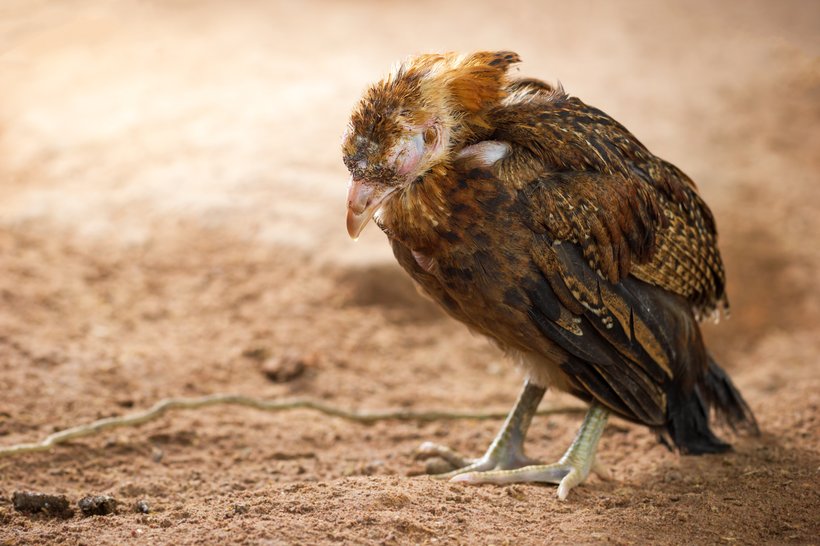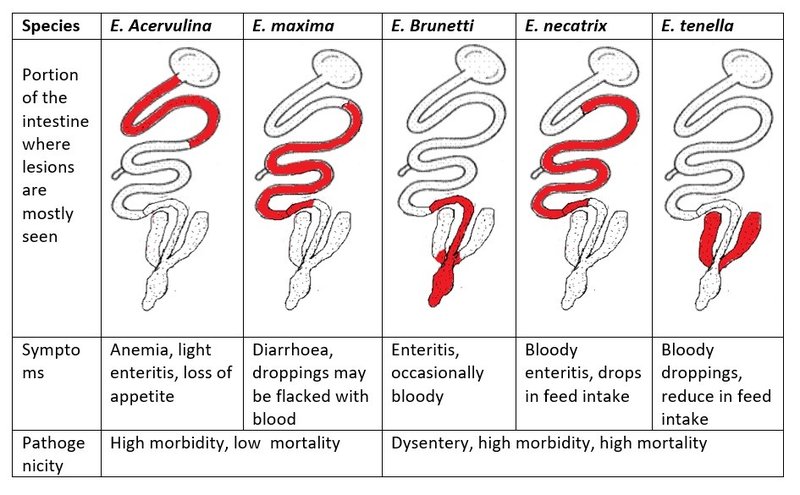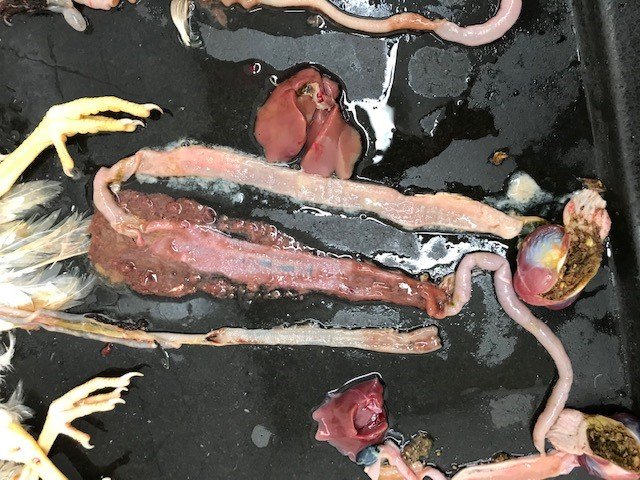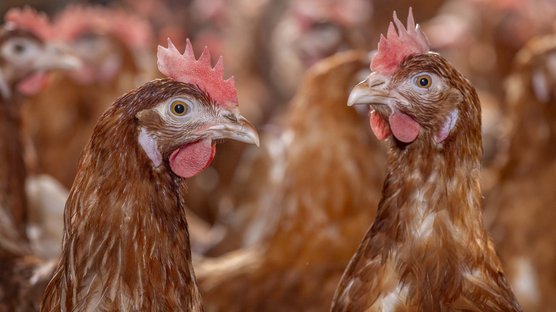
Published on May 10, 2021
Coccidiosis in poultry
Coccidiosis in poultry is one of the most economically significant parasitic diseases affecting chickens around the world. It is caused by protozoan parasites of the genus Eimeria, which damage the intestinal lining, leading to reduced feed efficiency, diarrhea, poor growth, and even death in severe cases. This highly contagious disease spreads rapidly, especially in warm, humid environments with poor litter management.
Controlling chicken coccidiosis requires a well-rounded approach that includes good husbandry, biosecurity, and effective vaccination. Understanding the coccidia life cycle, symptoms, and treatment options is crucial for maintaining healthy flocks and protecting productivity in both broiler and layer systems.
What Causes Coccidiosis in Poultry?
Eimeria in poultry are host-specific protozoan parasites transmitted through the fecal-oral route. After ingestion, these parasites invade the intestinal lining and replicate within cells, causing tissue damage. The average coccidia life cycle lasts 7 days, and no intermediate host is needed—making mechanical spread through contaminated litter, people, or equipment a major concern.
Common Eimeria species affecting chickens include:
- Eimeria acervulina
- Eimeria brunetti
- Eimeria maxima
- Eimeria mitis
- Eimeria mivati
- Eimeria necatrix
- Eimeria praecox
- Eimeria tenella
Each species targets specific areas of the intestine, and the severity of the disease depends on the species involved, infection level, bird age, and immune status.

The above picture is obtained from Dr. Amit Kumar Pandey
Symptoms of Coccidiosis in Poultry
Recognizing the symptoms of coccidiosis in poultry early is key to preventing serious losses. Common clinical signs include:
- Diarrhea, often with blood
- Lethargy and weakness
- Ruffled feathers and pale combs
- Reduced feed and water intake
- Poor growth or weight loss
- Increased mortality
- Decreased performance
- Poor uniformity
- Secondary infections
Clinical signs
The intestinal damage caused by Eimeria in poultry can also lead to nutrient malabsorption and increased vulnerability to secondary infections such as Clostridium perfringens, which causes necrotic enteritis.
Coccidia are single celled protozoan parasites of the Eimeria genus. Coccidia are transmitted from bird to bird fecal-orally, and the life cycle takes on average 7 days. Eimeria species are host specific. Coccidiosis disease in poultry is characterized by enteritis and intestinal cellular tissue damage. Intestinal damage is due to coccidia replication in the epithelial lining of the gastrointestinal tract. Symptoms of coccidiosis in poultry infection include bloody feces, malabsorption issues, decreased performance, and mortality.
Diagnosing Chicken Coccidiosis
Diagnosis of coccidiosis disease in poultry is based on clinical signs, post-mortem lesions, and microscopic identification of oocysts. Certain species like Eimeria tenella and Eimeria necatrix are easy to identify due to their characteristic damage: hemorrhagic ceca or grape-jelly-like feces. Fresh fecal samples can also be analyzed using oocyst counts to assess flock infection levels.
Coccidia Life Cycle: Why Timing Matters
The coccidia life cycle is a crucial consideration in disease prevention and vaccination strategies. After ingestion, coccidia go through multiple stages of asexual and sexual reproduction, eventually forming oocysts that are shed into the litter. Understanding this cycle helps manage timing for coccidiosis vaccine poultry programs, especially in cage-free or floor systems where birds are naturally exposed to their feces.
Coccidia is a protozoan parasite that relies on the chicken as a host for its replication. There are no intermediate hosts involved in the epidemiology. Spread is mechanical by people and equipment. Coccidia oocysts are ubiquitous in the environment. Eimeria species have an 83 hour to 7-day life cycle from when they are ingested to when oocysts are excreted to litter. The coccidia oocyst must incubate and go through sporulation to become infective. The barn environment must be ideal to produce sporulated oocysts with about 25% moisture, available oxygen, and heat. After sporulation, each oocyst has 8 infective sporozoites within its cell wall. Upon ingestion, the chicken’s gizzard and proventriculus break down the cell walls around the sporozoites allowing for their invasion of intestinal epithelial cells where they undergo several cycles of asexual and sexual reproduction. Each reproduction cycle results in further intestinal damage due to Eimeria rupturing the cell wall and infecting new cells at the end of each cycle. The coccidia life cycle is important to keep in mind when managing Eimeria vaccination programs and in cage-free production.
Prevention and Control: Coccidiosis Vaccine for Chickens
Coccidiosis in poultry prevention involves a combination of good litter management, proper ventilation, biosecurity, and strategic vaccination. The coccidiosis vaccine for chickens is a live vaccine that contains multiple attenuated Eimeria species, providing targeted immunity without cross-protection.
Key points for a successful Eimeria in poultry vaccination program:
- Administer vaccines at hatchery or early in the rearing farm
- Allow repeated exposure to oocysts for 3–4 weeks to build immunity
- Maintain relative humidity (35–60%) for oocyst sporulation
- Ensure birds have access to their droppings for full cycling
- Expect mild signs (e.g. loose droppings) during immune response
During the cycling phase, monitor bird behavior and adjust barn temperature (+2°F) if the chickens appear cold or inactive.

Damage to the intestinal wall caused by E. necatrix
Chicken Coccidiosis Treatment
If signs of severe infection or mortality are observed, treatment for coccidiosis in poultry should be initiated quickly. While vaccinated birds generally do not require treatment, a short, low-dose anticoccidial intervention (usually 2 days) may be necessary during vaccine cycling. Co-infections with bacteria like Clostridium perfringens may require additional therapy.
Always consult a poultry veterinarian for the most effective chicken coccidiosis treatment plan based on flock condition and vaccination status.
In conclusion
Coccidiosis in poultry remains a persistent challenge in commercial and backyard poultry operations. Understanding the symptoms of coccidiosis in poultry, identifying the specific Eimeria in poultry involved, and implementing a robust prevention plan—especially using a coccidiosis vaccine for chickens—are essential to minimizing economic losses and safeguarding bird health.
References
- Hector M. Cervantes, Larry R. McDougal and Mark C. Jenkins. Diseases of Poultry, 14th Edition
- H.W. Peek and W.J.M. Landman. Veterinary Quarterly, Vol. 31, No. 3.
- Lean J. Broom. World’s Poultry Science Journal 2021, Vol.77, No1.



